An Analysis of Human Factors in Healthcare: Safety and Quality
VerifiedAdded on 2020/05/03
|8
|2504
|198
Report
AI Summary
This report provides a comprehensive overview of the critical role of human factors in healthcare, emphasizing their impact on patient safety and overall quality. It explores various aspects, including the significance of human factors in managing healthcare processes, designing systems, and addressing human limitations. The report highlights the importance of risk management, organizational systems, and the integration of human factors frameworks to minimize errors, improve teamwork, and enhance communication among healthcare staff. It discusses the application of the SRC Theory, the impact of safety and risk management culture, and the need for leadership support in aligning patient safety, quality, and risk functions. The report concludes by emphasizing the need for healthcare institutions to be aware of the changing managerial culture that improves patient safety and the benefits of collaborative approaches in addressing healthcare challenges.
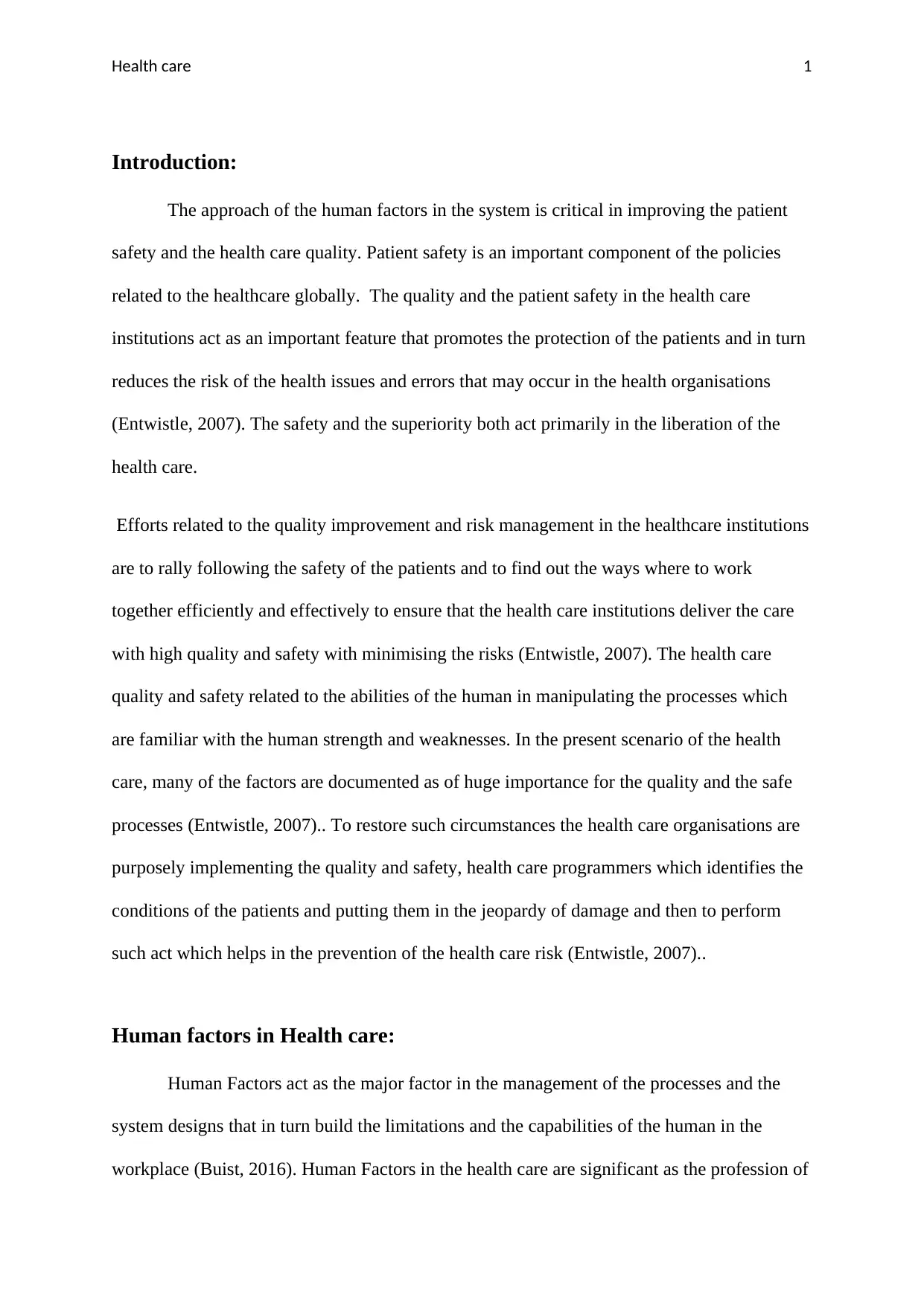
Health care 1
Introduction:
The approach of the human factors in the system is critical in improving the patient
safety and the health care quality. Patient safety is an important component of the policies
related to the healthcare globally. The quality and the patient safety in the health care
institutions act as an important feature that promotes the protection of the patients and in turn
reduces the risk of the health issues and errors that may occur in the health organisations
(Entwistle, 2007). The safety and the superiority both act primarily in the liberation of the
health care.
Efforts related to the quality improvement and risk management in the healthcare institutions
are to rally following the safety of the patients and to find out the ways where to work
together efficiently and effectively to ensure that the health care institutions deliver the care
with high quality and safety with minimising the risks (Entwistle, 2007). The health care
quality and safety related to the abilities of the human in manipulating the processes which
are familiar with the human strength and weaknesses. In the present scenario of the health
care, many of the factors are documented as of huge importance for the quality and the safe
processes (Entwistle, 2007).. To restore such circumstances the health care organisations are
purposely implementing the quality and safety, health care programmers which identifies the
conditions of the patients and putting them in the jeopardy of damage and then to perform
such act which helps in the prevention of the health care risk (Entwistle, 2007)..
Human factors in Health care:
Human Factors act as the major factor in the management of the processes and the
system designs that in turn build the limitations and the capabilities of the human in the
workplace (Buist, 2016). Human Factors in the health care are significant as the profession of
Introduction:
The approach of the human factors in the system is critical in improving the patient
safety and the health care quality. Patient safety is an important component of the policies
related to the healthcare globally. The quality and the patient safety in the health care
institutions act as an important feature that promotes the protection of the patients and in turn
reduces the risk of the health issues and errors that may occur in the health organisations
(Entwistle, 2007). The safety and the superiority both act primarily in the liberation of the
health care.
Efforts related to the quality improvement and risk management in the healthcare institutions
are to rally following the safety of the patients and to find out the ways where to work
together efficiently and effectively to ensure that the health care institutions deliver the care
with high quality and safety with minimising the risks (Entwistle, 2007). The health care
quality and safety related to the abilities of the human in manipulating the processes which
are familiar with the human strength and weaknesses. In the present scenario of the health
care, many of the factors are documented as of huge importance for the quality and the safe
processes (Entwistle, 2007).. To restore such circumstances the health care organisations are
purposely implementing the quality and safety, health care programmers which identifies the
conditions of the patients and putting them in the jeopardy of damage and then to perform
such act which helps in the prevention of the health care risk (Entwistle, 2007)..
Human factors in Health care:
Human Factors act as the major factor in the management of the processes and the
system designs that in turn build the limitations and the capabilities of the human in the
workplace (Buist, 2016). Human Factors in the health care are significant as the profession of
Paraphrase This Document
Need a fresh take? Get an instant paraphrase of this document with our AI Paraphraser
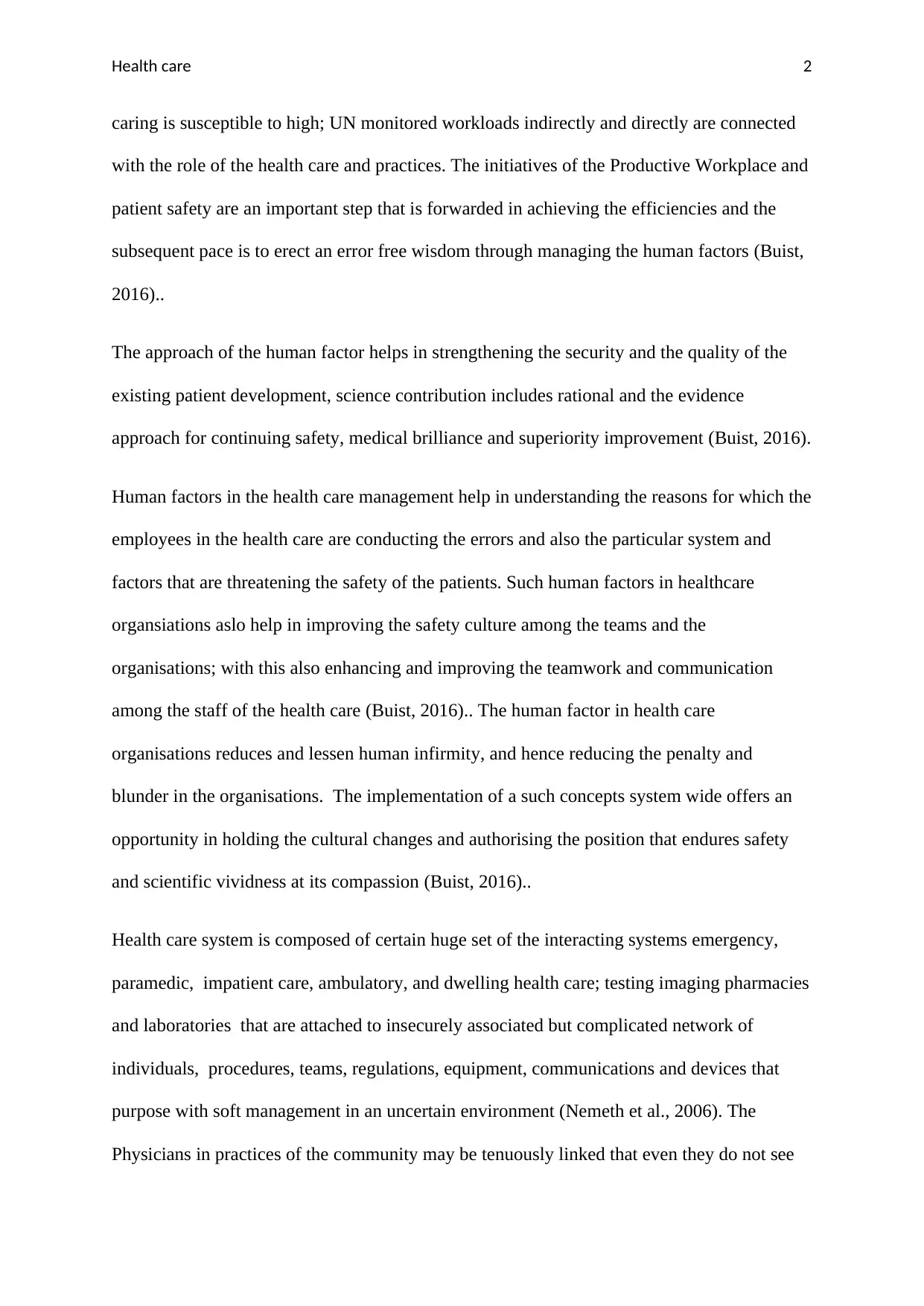
Health care 2
caring is susceptible to high; UN monitored workloads indirectly and directly are connected
with the role of the health care and practices. The initiatives of the Productive Workplace and
patient safety are an important step that is forwarded in achieving the efficiencies and the
subsequent pace is to erect an error free wisdom through managing the human factors (Buist,
2016)..
The approach of the human factor helps in strengthening the security and the quality of the
existing patient development, science contribution includes rational and the evidence
approach for continuing safety, medical brilliance and superiority improvement (Buist, 2016).
Human factors in the health care management help in understanding the reasons for which the
employees in the health care are conducting the errors and also the particular system and
factors that are threatening the safety of the patients. Such human factors in healthcare
organsiations aslo help in improving the safety culture among the teams and the
organisations; with this also enhancing and improving the teamwork and communication
among the staff of the health care (Buist, 2016).. The human factor in health care
organisations reduces and lessen human infirmity, and hence reducing the penalty and
blunder in the organisations. The implementation of a such concepts system wide offers an
opportunity in holding the cultural changes and authorising the position that endures safety
and scientific vividness at its compassion (Buist, 2016)..
Health care system is composed of certain huge set of the interacting systems emergency,
paramedic, impatient care, ambulatory, and dwelling health care; testing imaging pharmacies
and laboratories that are attached to insecurely associated but complicated network of
individuals, procedures, teams, regulations, equipment, communications and devices that
purpose with soft management in an uncertain environment (Nemeth et al., 2006). The
Physicians in practices of the community may be tenuously linked that even they do not see
caring is susceptible to high; UN monitored workloads indirectly and directly are connected
with the role of the health care and practices. The initiatives of the Productive Workplace and
patient safety are an important step that is forwarded in achieving the efficiencies and the
subsequent pace is to erect an error free wisdom through managing the human factors (Buist,
2016)..
The approach of the human factor helps in strengthening the security and the quality of the
existing patient development, science contribution includes rational and the evidence
approach for continuing safety, medical brilliance and superiority improvement (Buist, 2016).
Human factors in the health care management help in understanding the reasons for which the
employees in the health care are conducting the errors and also the particular system and
factors that are threatening the safety of the patients. Such human factors in healthcare
organsiations aslo help in improving the safety culture among the teams and the
organisations; with this also enhancing and improving the teamwork and communication
among the staff of the health care (Buist, 2016).. The human factor in health care
organisations reduces and lessen human infirmity, and hence reducing the penalty and
blunder in the organisations. The implementation of a such concepts system wide offers an
opportunity in holding the cultural changes and authorising the position that endures safety
and scientific vividness at its compassion (Buist, 2016)..
Health care system is composed of certain huge set of the interacting systems emergency,
paramedic, impatient care, ambulatory, and dwelling health care; testing imaging pharmacies
and laboratories that are attached to insecurely associated but complicated network of
individuals, procedures, teams, regulations, equipment, communications and devices that
purpose with soft management in an uncertain environment (Nemeth et al., 2006). The
Physicians in practices of the community may be tenuously linked that even they do not see
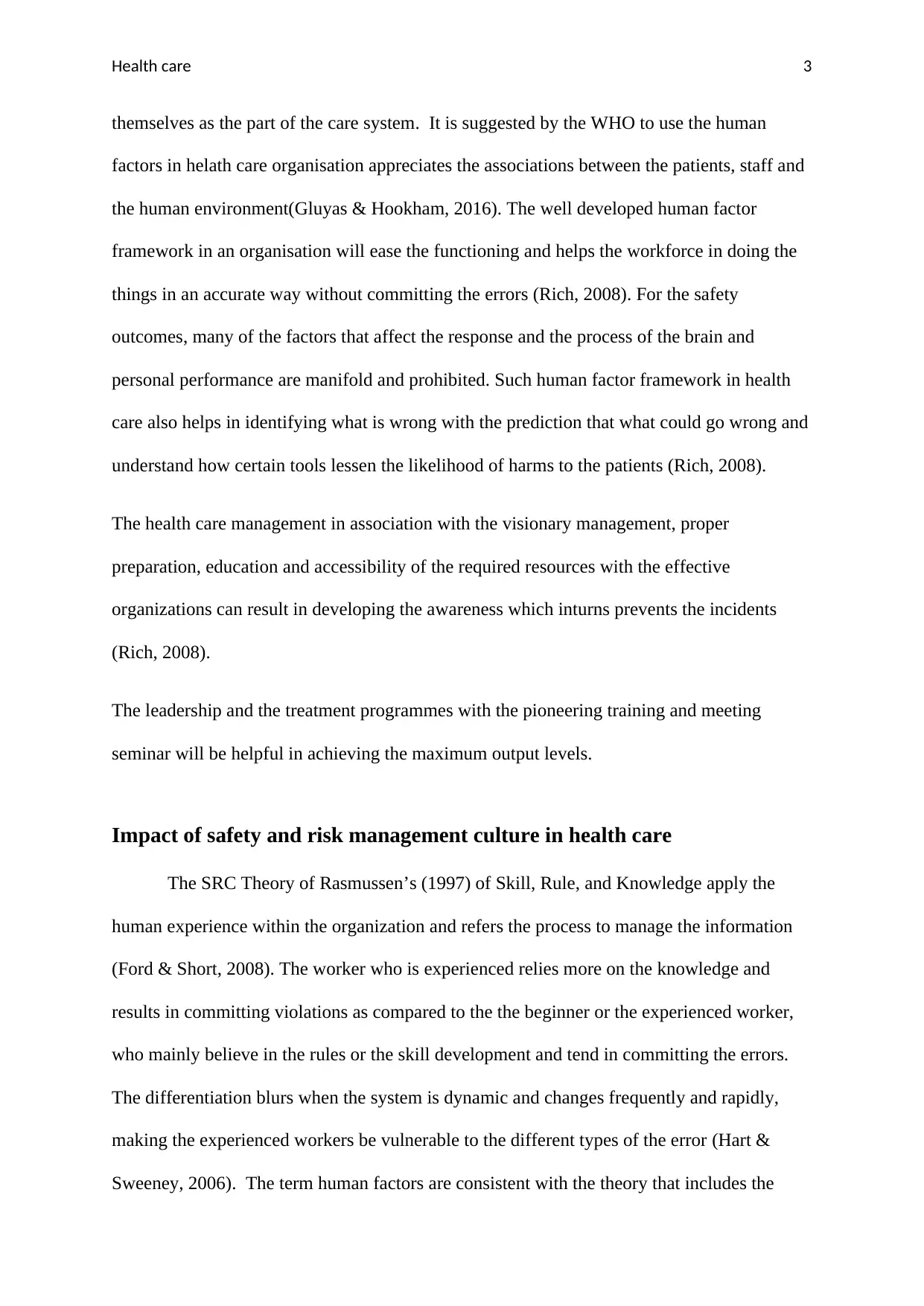
Health care 3
themselves as the part of the care system. It is suggested by the WHO to use the human
factors in helath care organisation appreciates the associations between the patients, staff and
the human environment(Gluyas & Hookham, 2016). The well developed human factor
framework in an organisation will ease the functioning and helps the workforce in doing the
things in an accurate way without committing the errors (Rich, 2008). For the safety
outcomes, many of the factors that affect the response and the process of the brain and
personal performance are manifold and prohibited. Such human factor framework in health
care also helps in identifying what is wrong with the prediction that what could go wrong and
understand how certain tools lessen the likelihood of harms to the patients (Rich, 2008).
The health care management in association with the visionary management, proper
preparation, education and accessibility of the required resources with the effective
organizations can result in developing the awareness which inturns prevents the incidents
(Rich, 2008).
The leadership and the treatment programmes with the pioneering training and meeting
seminar will be helpful in achieving the maximum output levels.
Impact of safety and risk management culture in health care
The SRC Theory of Rasmussen’s (1997) of Skill, Rule, and Knowledge apply the
human experience within the organization and refers the process to manage the information
(Ford & Short, 2008). The worker who is experienced relies more on the knowledge and
results in committing violations as compared to the the beginner or the experienced worker,
who mainly believe in the rules or the skill development and tend in committing the errors.
The differentiation blurs when the system is dynamic and changes frequently and rapidly,
making the experienced workers be vulnerable to the different types of the error (Hart &
Sweeney, 2006). The term human factors are consistent with the theory that includes the
themselves as the part of the care system. It is suggested by the WHO to use the human
factors in helath care organisation appreciates the associations between the patients, staff and
the human environment(Gluyas & Hookham, 2016). The well developed human factor
framework in an organisation will ease the functioning and helps the workforce in doing the
things in an accurate way without committing the errors (Rich, 2008). For the safety
outcomes, many of the factors that affect the response and the process of the brain and
personal performance are manifold and prohibited. Such human factor framework in health
care also helps in identifying what is wrong with the prediction that what could go wrong and
understand how certain tools lessen the likelihood of harms to the patients (Rich, 2008).
The health care management in association with the visionary management, proper
preparation, education and accessibility of the required resources with the effective
organizations can result in developing the awareness which inturns prevents the incidents
(Rich, 2008).
The leadership and the treatment programmes with the pioneering training and meeting
seminar will be helpful in achieving the maximum output levels.
Impact of safety and risk management culture in health care
The SRC Theory of Rasmussen’s (1997) of Skill, Rule, and Knowledge apply the
human experience within the organization and refers the process to manage the information
(Ford & Short, 2008). The worker who is experienced relies more on the knowledge and
results in committing violations as compared to the the beginner or the experienced worker,
who mainly believe in the rules or the skill development and tend in committing the errors.
The differentiation blurs when the system is dynamic and changes frequently and rapidly,
making the experienced workers be vulnerable to the different types of the error (Hart &
Sweeney, 2006). The term human factors are consistent with the theory that includes the
⊘ This is a preview!⊘
Do you want full access?
Subscribe today to unlock all pages.

Trusted by 1+ million students worldwide
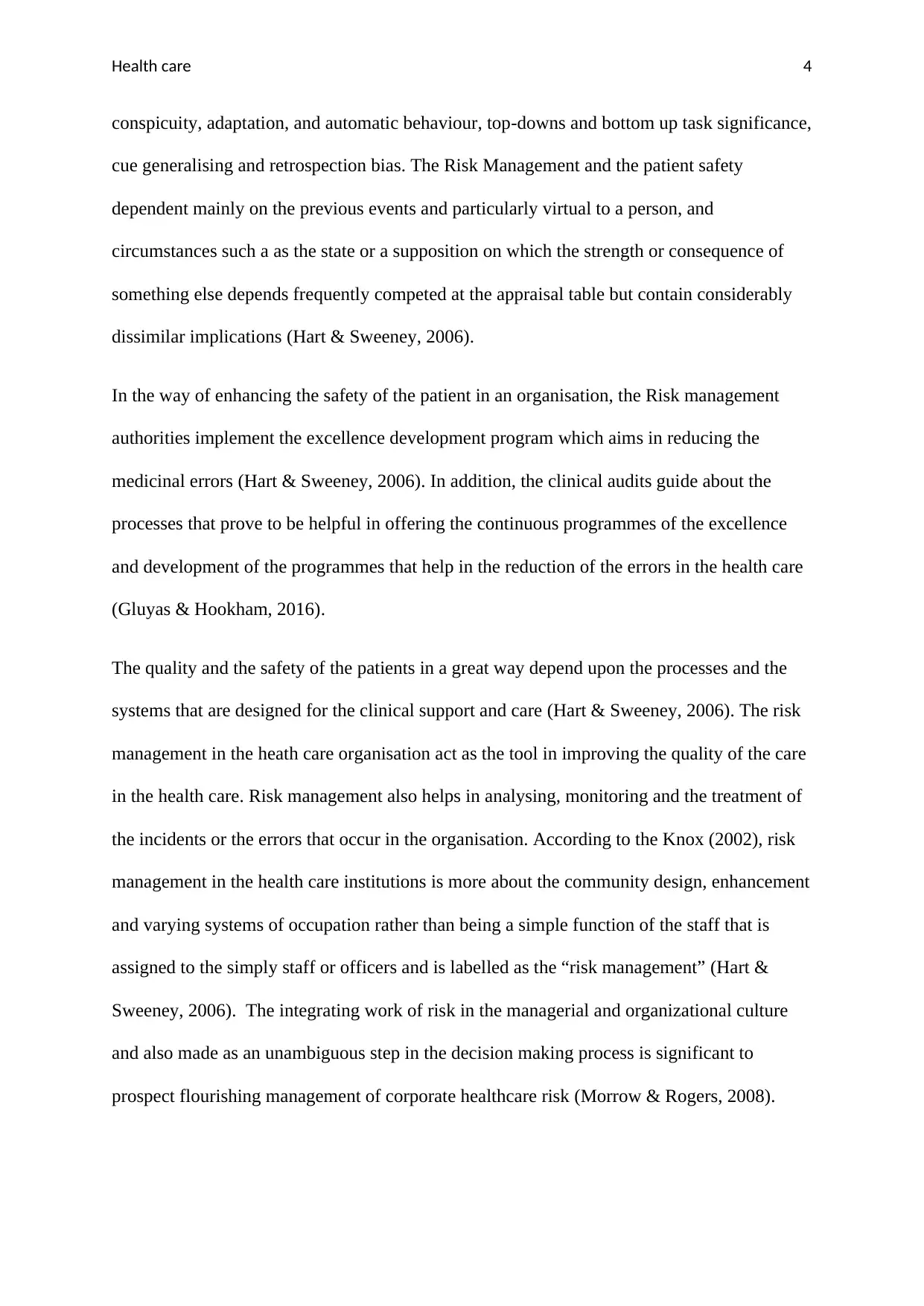
Health care 4
conspicuity, adaptation, and automatic behaviour, top-downs and bottom up task significance,
cue generalising and retrospection bias. The Risk Management and the patient safety
dependent mainly on the previous events and particularly virtual to a person, and
circumstances such a as the state or a supposition on which the strength or consequence of
something else depends frequently competed at the appraisal table but contain considerably
dissimilar implications (Hart & Sweeney, 2006).
In the way of enhancing the safety of the patient in an organisation, the Risk management
authorities implement the excellence development program which aims in reducing the
medicinal errors (Hart & Sweeney, 2006). In addition, the clinical audits guide about the
processes that prove to be helpful in offering the continuous programmes of the excellence
and development of the programmes that help in the reduction of the errors in the health care
(Gluyas & Hookham, 2016).
The quality and the safety of the patients in a great way depend upon the processes and the
systems that are designed for the clinical support and care (Hart & Sweeney, 2006). The risk
management in the heath care organisation act as the tool in improving the quality of the care
in the health care. Risk management also helps in analysing, monitoring and the treatment of
the incidents or the errors that occur in the organisation. According to the Knox (2002), risk
management in the health care institutions is more about the community design, enhancement
and varying systems of occupation rather than being a simple function of the staff that is
assigned to the simply staff or officers and is labelled as the “risk management” (Hart &
Sweeney, 2006). The integrating work of risk in the managerial and organizational culture
and also made as an unambiguous step in the decision making process is significant to
prospect flourishing management of corporate healthcare risk (Morrow & Rogers, 2008).
conspicuity, adaptation, and automatic behaviour, top-downs and bottom up task significance,
cue generalising and retrospection bias. The Risk Management and the patient safety
dependent mainly on the previous events and particularly virtual to a person, and
circumstances such a as the state or a supposition on which the strength or consequence of
something else depends frequently competed at the appraisal table but contain considerably
dissimilar implications (Hart & Sweeney, 2006).
In the way of enhancing the safety of the patient in an organisation, the Risk management
authorities implement the excellence development program which aims in reducing the
medicinal errors (Hart & Sweeney, 2006). In addition, the clinical audits guide about the
processes that prove to be helpful in offering the continuous programmes of the excellence
and development of the programmes that help in the reduction of the errors in the health care
(Gluyas & Hookham, 2016).
The quality and the safety of the patients in a great way depend upon the processes and the
systems that are designed for the clinical support and care (Hart & Sweeney, 2006). The risk
management in the heath care organisation act as the tool in improving the quality of the care
in the health care. Risk management also helps in analysing, monitoring and the treatment of
the incidents or the errors that occur in the organisation. According to the Knox (2002), risk
management in the health care institutions is more about the community design, enhancement
and varying systems of occupation rather than being a simple function of the staff that is
assigned to the simply staff or officers and is labelled as the “risk management” (Hart &
Sweeney, 2006). The integrating work of risk in the managerial and organizational culture
and also made as an unambiguous step in the decision making process is significant to
prospect flourishing management of corporate healthcare risk (Morrow & Rogers, 2008).
Paraphrase This Document
Need a fresh take? Get an instant paraphrase of this document with our AI Paraphraser
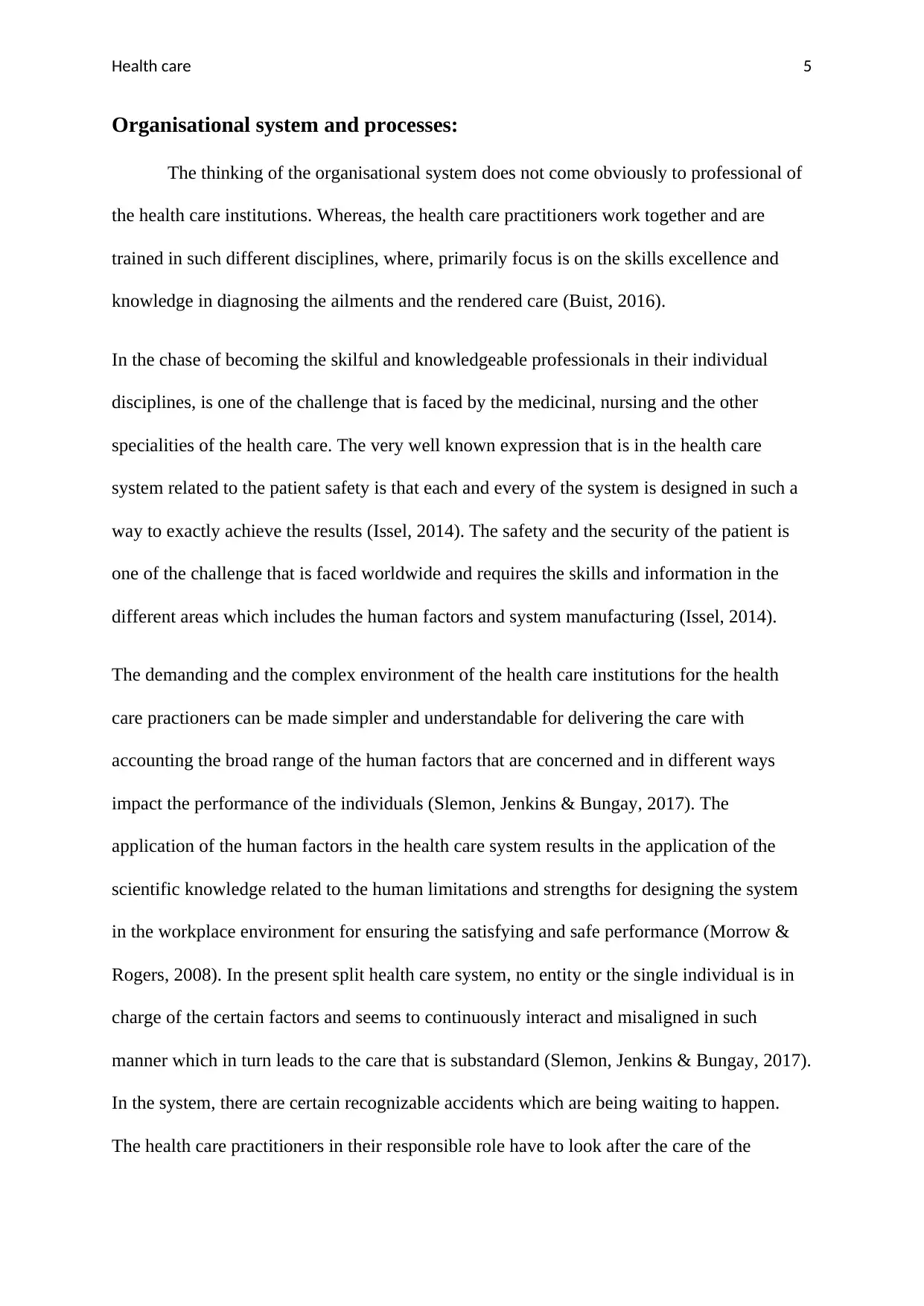
Health care 5
Organisational system and processes:
The thinking of the organisational system does not come obviously to professional of
the health care institutions. Whereas, the health care practitioners work together and are
trained in such different disciplines, where, primarily focus is on the skills excellence and
knowledge in diagnosing the ailments and the rendered care (Buist, 2016).
In the chase of becoming the skilful and knowledgeable professionals in their individual
disciplines, is one of the challenge that is faced by the medicinal, nursing and the other
specialities of the health care. The very well known expression that is in the health care
system related to the patient safety is that each and every of the system is designed in such a
way to exactly achieve the results (Issel, 2014). The safety and the security of the patient is
one of the challenge that is faced worldwide and requires the skills and information in the
different areas which includes the human factors and system manufacturing (Issel, 2014).
The demanding and the complex environment of the health care institutions for the health
care practioners can be made simpler and understandable for delivering the care with
accounting the broad range of the human factors that are concerned and in different ways
impact the performance of the individuals (Slemon, Jenkins & Bungay, 2017). The
application of the human factors in the health care system results in the application of the
scientific knowledge related to the human limitations and strengths for designing the system
in the workplace environment for ensuring the satisfying and safe performance (Morrow &
Rogers, 2008). In the present split health care system, no entity or the single individual is in
charge of the certain factors and seems to continuously interact and misaligned in such
manner which in turn leads to the care that is substandard (Slemon, Jenkins & Bungay, 2017).
In the system, there are certain recognizable accidents which are being waiting to happen.
The health care practitioners in their responsible role have to look after the care of the
Organisational system and processes:
The thinking of the organisational system does not come obviously to professional of
the health care institutions. Whereas, the health care practitioners work together and are
trained in such different disciplines, where, primarily focus is on the skills excellence and
knowledge in diagnosing the ailments and the rendered care (Buist, 2016).
In the chase of becoming the skilful and knowledgeable professionals in their individual
disciplines, is one of the challenge that is faced by the medicinal, nursing and the other
specialities of the health care. The very well known expression that is in the health care
system related to the patient safety is that each and every of the system is designed in such a
way to exactly achieve the results (Issel, 2014). The safety and the security of the patient is
one of the challenge that is faced worldwide and requires the skills and information in the
different areas which includes the human factors and system manufacturing (Issel, 2014).
The demanding and the complex environment of the health care institutions for the health
care practioners can be made simpler and understandable for delivering the care with
accounting the broad range of the human factors that are concerned and in different ways
impact the performance of the individuals (Slemon, Jenkins & Bungay, 2017). The
application of the human factors in the health care system results in the application of the
scientific knowledge related to the human limitations and strengths for designing the system
in the workplace environment for ensuring the satisfying and safe performance (Morrow &
Rogers, 2008). In the present split health care system, no entity or the single individual is in
charge of the certain factors and seems to continuously interact and misaligned in such
manner which in turn leads to the care that is substandard (Slemon, Jenkins & Bungay, 2017).
In the system, there are certain recognizable accidents which are being waiting to happen.
The health care practitioners in their responsible role have to look after the care of the
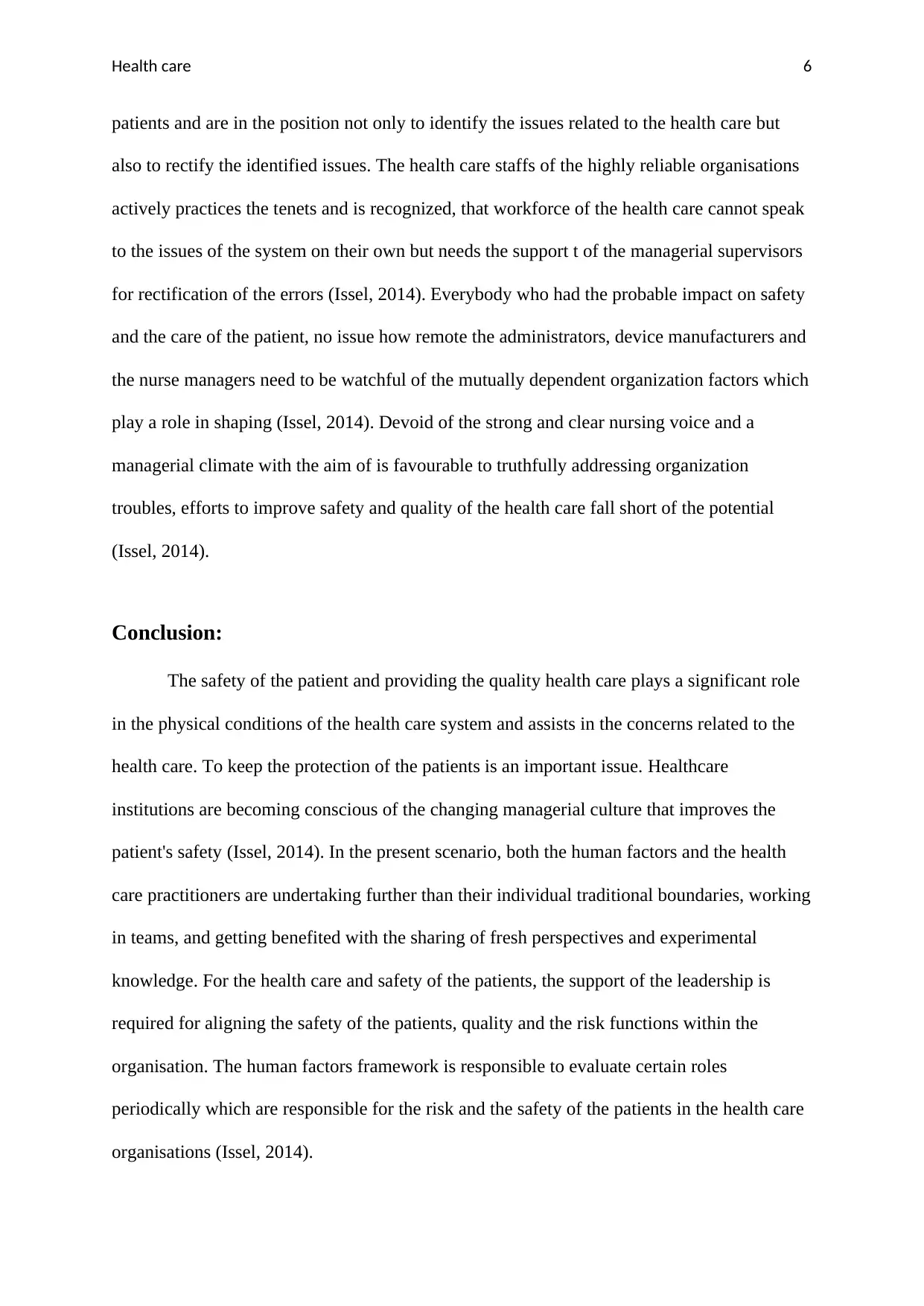
Health care 6
patients and are in the position not only to identify the issues related to the health care but
also to rectify the identified issues. The health care staffs of the highly reliable organisations
actively practices the tenets and is recognized, that workforce of the health care cannot speak
to the issues of the system on their own but needs the support t of the managerial supervisors
for rectification of the errors (Issel, 2014). Everybody who had the probable impact on safety
and the care of the patient, no issue how remote the administrators, device manufacturers and
the nurse managers need to be watchful of the mutually dependent organization factors which
play a role in shaping (Issel, 2014). Devoid of the strong and clear nursing voice and a
managerial climate with the aim of is favourable to truthfully addressing organization
troubles, efforts to improve safety and quality of the health care fall short of the potential
(Issel, 2014).
Conclusion:
The safety of the patient and providing the quality health care plays a significant role
in the physical conditions of the health care system and assists in the concerns related to the
health care. To keep the protection of the patients is an important issue. Healthcare
institutions are becoming conscious of the changing managerial culture that improves the
patient's safety (Issel, 2014). In the present scenario, both the human factors and the health
care practitioners are undertaking further than their individual traditional boundaries, working
in teams, and getting benefited with the sharing of fresh perspectives and experimental
knowledge. For the health care and safety of the patients, the support of the leadership is
required for aligning the safety of the patients, quality and the risk functions within the
organisation. The human factors framework is responsible to evaluate certain roles
periodically which are responsible for the risk and the safety of the patients in the health care
organisations (Issel, 2014).
patients and are in the position not only to identify the issues related to the health care but
also to rectify the identified issues. The health care staffs of the highly reliable organisations
actively practices the tenets and is recognized, that workforce of the health care cannot speak
to the issues of the system on their own but needs the support t of the managerial supervisors
for rectification of the errors (Issel, 2014). Everybody who had the probable impact on safety
and the care of the patient, no issue how remote the administrators, device manufacturers and
the nurse managers need to be watchful of the mutually dependent organization factors which
play a role in shaping (Issel, 2014). Devoid of the strong and clear nursing voice and a
managerial climate with the aim of is favourable to truthfully addressing organization
troubles, efforts to improve safety and quality of the health care fall short of the potential
(Issel, 2014).
Conclusion:
The safety of the patient and providing the quality health care plays a significant role
in the physical conditions of the health care system and assists in the concerns related to the
health care. To keep the protection of the patients is an important issue. Healthcare
institutions are becoming conscious of the changing managerial culture that improves the
patient's safety (Issel, 2014). In the present scenario, both the human factors and the health
care practitioners are undertaking further than their individual traditional boundaries, working
in teams, and getting benefited with the sharing of fresh perspectives and experimental
knowledge. For the health care and safety of the patients, the support of the leadership is
required for aligning the safety of the patients, quality and the risk functions within the
organisation. The human factors framework is responsible to evaluate certain roles
periodically which are responsible for the risk and the safety of the patients in the health care
organisations (Issel, 2014).
⊘ This is a preview!⊘
Do you want full access?
Subscribe today to unlock all pages.

Trusted by 1+ million students worldwide
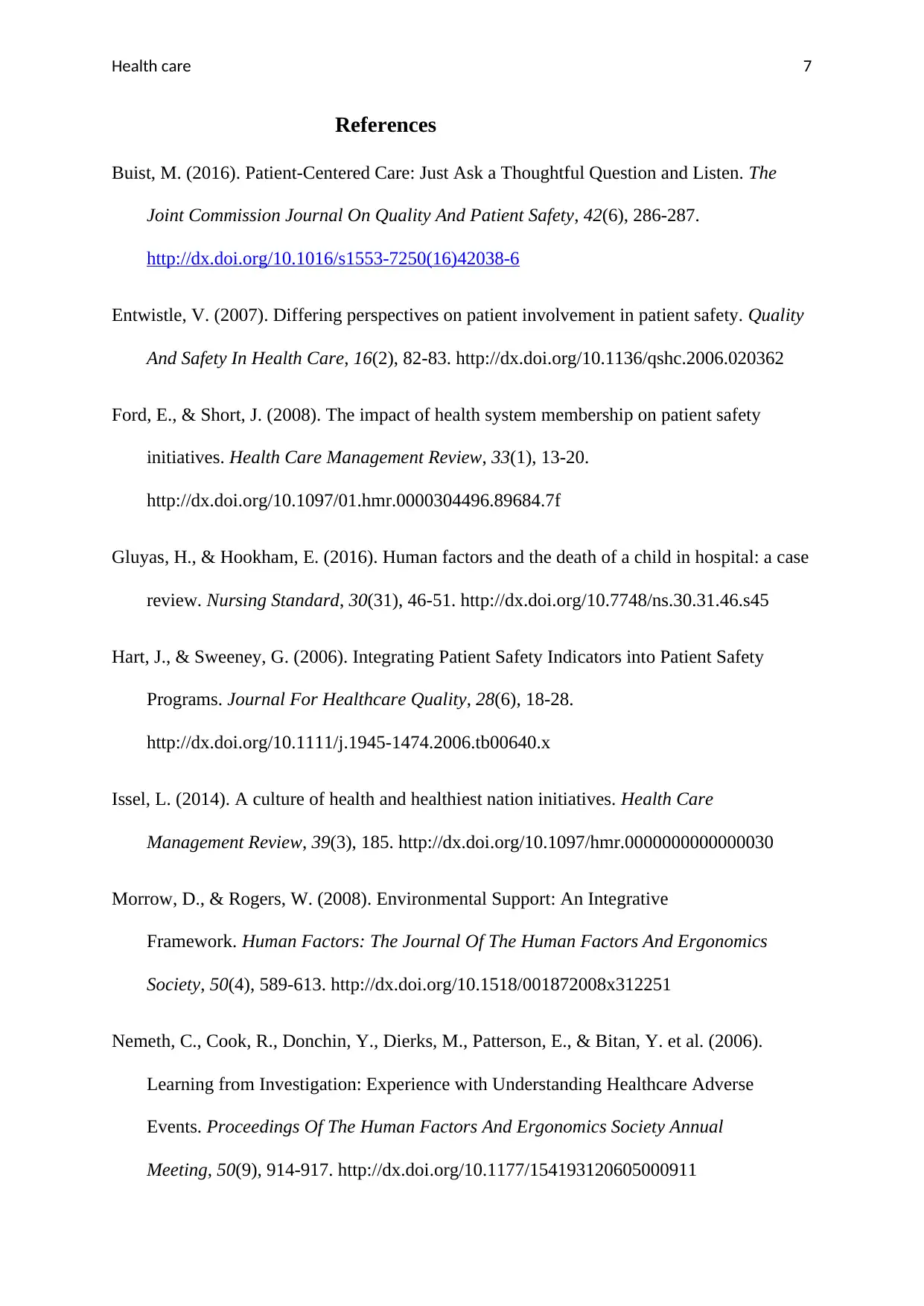
Health care 7
References
Buist, M. (2016). Patient-Centered Care: Just Ask a Thoughtful Question and Listen. The
Joint Commission Journal On Quality And Patient Safety, 42(6), 286-287.
http://dx.doi.org/10.1016/s1553-7250(16)42038-6
Entwistle, V. (2007). Differing perspectives on patient involvement in patient safety. Quality
And Safety In Health Care, 16(2), 82-83. http://dx.doi.org/10.1136/qshc.2006.020362
Ford, E., & Short, J. (2008). The impact of health system membership on patient safety
initiatives. Health Care Management Review, 33(1), 13-20.
http://dx.doi.org/10.1097/01.hmr.0000304496.89684.7f
Gluyas, H., & Hookham, E. (2016). Human factors and the death of a child in hospital: a case
review. Nursing Standard, 30(31), 46-51. http://dx.doi.org/10.7748/ns.30.31.46.s45
Hart, J., & Sweeney, G. (2006). Integrating Patient Safety Indicators into Patient Safety
Programs. Journal For Healthcare Quality, 28(6), 18-28.
http://dx.doi.org/10.1111/j.1945-1474.2006.tb00640.x
Issel, L. (2014). A culture of health and healthiest nation initiatives. Health Care
Management Review, 39(3), 185. http://dx.doi.org/10.1097/hmr.0000000000000030
Morrow, D., & Rogers, W. (2008). Environmental Support: An Integrative
Framework. Human Factors: The Journal Of The Human Factors And Ergonomics
Society, 50(4), 589-613. http://dx.doi.org/10.1518/001872008x312251
Nemeth, C., Cook, R., Donchin, Y., Dierks, M., Patterson, E., & Bitan, Y. et al. (2006).
Learning from Investigation: Experience with Understanding Healthcare Adverse
Events. Proceedings Of The Human Factors And Ergonomics Society Annual
Meeting, 50(9), 914-917. http://dx.doi.org/10.1177/154193120605000911
References
Buist, M. (2016). Patient-Centered Care: Just Ask a Thoughtful Question and Listen. The
Joint Commission Journal On Quality And Patient Safety, 42(6), 286-287.
http://dx.doi.org/10.1016/s1553-7250(16)42038-6
Entwistle, V. (2007). Differing perspectives on patient involvement in patient safety. Quality
And Safety In Health Care, 16(2), 82-83. http://dx.doi.org/10.1136/qshc.2006.020362
Ford, E., & Short, J. (2008). The impact of health system membership on patient safety
initiatives. Health Care Management Review, 33(1), 13-20.
http://dx.doi.org/10.1097/01.hmr.0000304496.89684.7f
Gluyas, H., & Hookham, E. (2016). Human factors and the death of a child in hospital: a case
review. Nursing Standard, 30(31), 46-51. http://dx.doi.org/10.7748/ns.30.31.46.s45
Hart, J., & Sweeney, G. (2006). Integrating Patient Safety Indicators into Patient Safety
Programs. Journal For Healthcare Quality, 28(6), 18-28.
http://dx.doi.org/10.1111/j.1945-1474.2006.tb00640.x
Issel, L. (2014). A culture of health and healthiest nation initiatives. Health Care
Management Review, 39(3), 185. http://dx.doi.org/10.1097/hmr.0000000000000030
Morrow, D., & Rogers, W. (2008). Environmental Support: An Integrative
Framework. Human Factors: The Journal Of The Human Factors And Ergonomics
Society, 50(4), 589-613. http://dx.doi.org/10.1518/001872008x312251
Nemeth, C., Cook, R., Donchin, Y., Dierks, M., Patterson, E., & Bitan, Y. et al. (2006).
Learning from Investigation: Experience with Understanding Healthcare Adverse
Events. Proceedings Of The Human Factors And Ergonomics Society Annual
Meeting, 50(9), 914-917. http://dx.doi.org/10.1177/154193120605000911
Paraphrase This Document
Need a fresh take? Get an instant paraphrase of this document with our AI Paraphraser
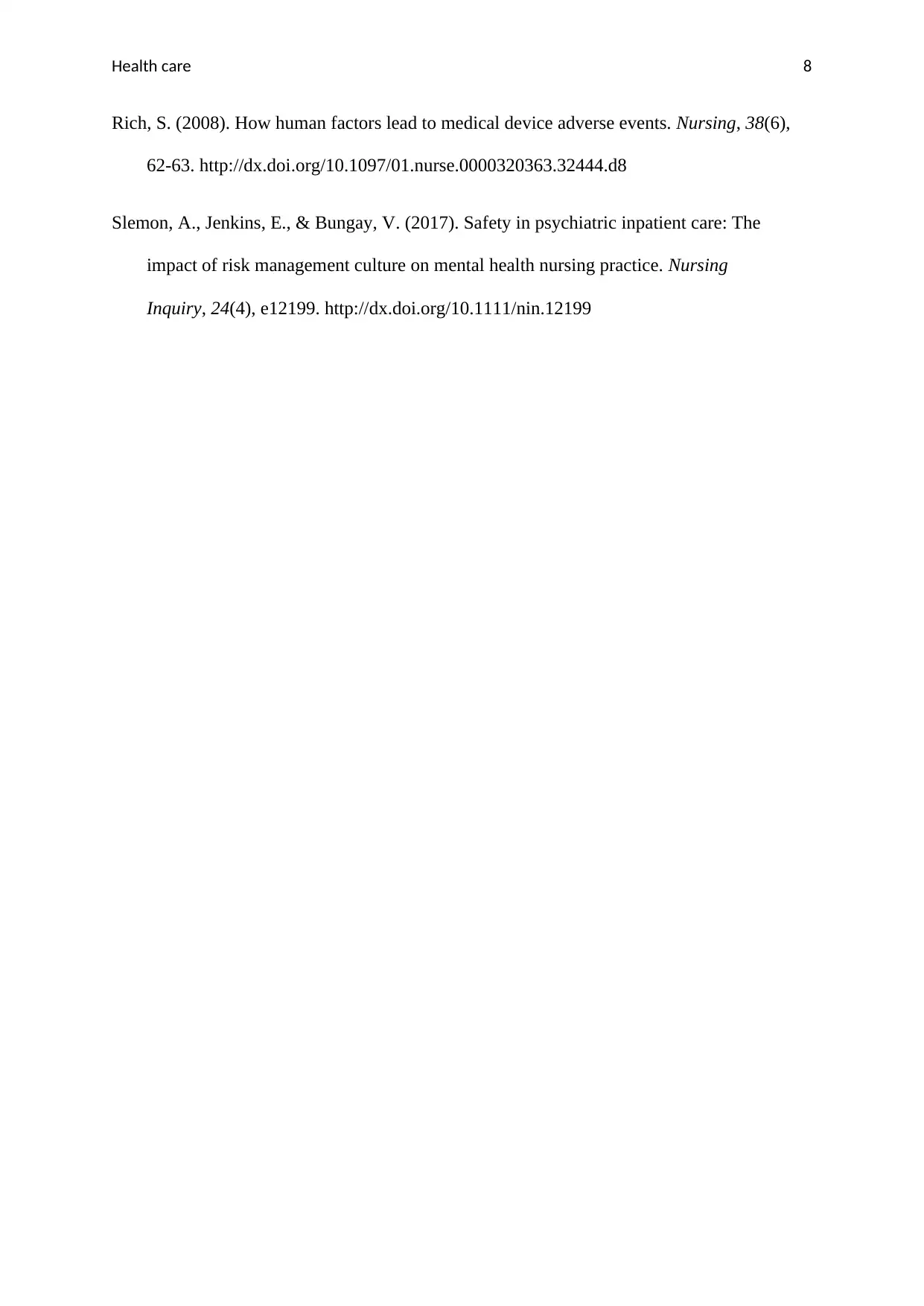
Health care 8
Rich, S. (2008). How human factors lead to medical device adverse events. Nursing, 38(6),
62-63. http://dx.doi.org/10.1097/01.nurse.0000320363.32444.d8
Slemon, A., Jenkins, E., & Bungay, V. (2017). Safety in psychiatric inpatient care: The
impact of risk management culture on mental health nursing practice. Nursing
Inquiry, 24(4), e12199. http://dx.doi.org/10.1111/nin.12199
Rich, S. (2008). How human factors lead to medical device adverse events. Nursing, 38(6),
62-63. http://dx.doi.org/10.1097/01.nurse.0000320363.32444.d8
Slemon, A., Jenkins, E., & Bungay, V. (2017). Safety in psychiatric inpatient care: The
impact of risk management culture on mental health nursing practice. Nursing
Inquiry, 24(4), e12199. http://dx.doi.org/10.1111/nin.12199
1 out of 8
Related Documents
Your All-in-One AI-Powered Toolkit for Academic Success.
+13062052269
info@desklib.com
Available 24*7 on WhatsApp / Email
![[object Object]](/_next/static/media/star-bottom.7253800d.svg)
Unlock your academic potential
Copyright © 2020–2025 A2Z Services. All Rights Reserved. Developed and managed by ZUCOL.





